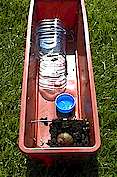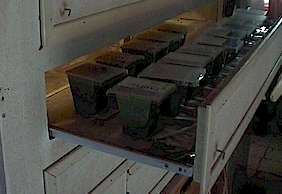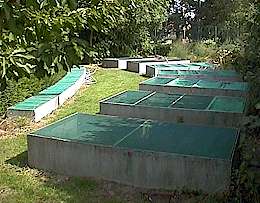visit of my breeding
system
(attention, my aim is to obtain a particular stock,
don't follow this method for usual breeding purpose ! )
reproduction:
from March to beginning of June. The breeders are put by pairs in
flowers- stands of 50 cm in length placed in a greenhouse. This one is not heated apart
from the effect of greenhouse, it is only maintained out-of frost with a thermostated
electric heating. The possible excess of heat is avoided by automatic aerators. The
couples which did not give a descent during the spring and which are particularly
interesting, are again put to reproduce at the end of August, mainly if it is a problem of
cycle of life according to their origin.

|

|
| the photographs were taken in
August |
the flowers stands contain on
this date either the future isolated reproducers, or the snail couples which did not have
a descent during spring; I can put a hundred boxes. |

|

|
| the plastic bottle protects food
from watering, the blue stopper is used as trough |
in this box we observe a laying |
The number of the box is also the number of the couple which
it contains, " 23 " for example, and the descendants of the couple 23 of the
year 1999 will carry numbers 99-23-1, 99-23-2, 99-23-3 etc...
incubation:
Eggs are left in the pot of laying, I check simply their presence by
removing the stopper left by the laying snail. The pots, numbered in their turn, are put
to incubate in the garage, in a heated cupboard which is always at 20░C (69 ░F) with
thermostat, and with a transparent lid which avoids dehydration, and will retain the
small babies...

nursery:
the pot of laying, with its small snails just hatched
and stuck under the lid, is placed in a flower stand of 50 cm identical to those used for
the couples, but equipped with another way:

|
there is a bottom of compost,
thick from 3 to 4 cm, quite wet. |
The nursery is done in the greenhouse, the flower stand sheltering
the small babies of a couple replacing that of this couple. It lasts 3 weeks on average.
final growth:
Each family is isolated and is thus placed in an individual pen of
small size.

|
|

|
| this pen measures 123 cm out of
65, its surface of 0.80 m▓ enables it to contain to 160 snails, that is to say a complete
family generally |
|
this very small pen measures 60
cm by 30 and can thus contain only one sample of 30 snails from a family |
 |
selection:
the future reproducers are preselected mainly according to their size, the color
of their shell (character unicolor) and their speed of growth, at a rate of 3 to 5 or 6
per family, according to the estimated total performances of the family. They must be
virgin (for pedigree), which implies their insulation rather early.
Preselected snails hibernate then in small individual boxes. Their quantity is higher
than that of the reproducers really used during following Spring, to face a possible
mortality and to keep any possibility of choice.
During the winter, I can study the passed season, and thus establish the plan of the
pairing for the following season, by taking of account the real performances of each
family (size, color, percentage of adult...) and for minimizing the rate of consanguinity.
Foreign snails, often 25% of the whole number of reproducers, are introduced to this
aim, and in order to bring various particular qualities. The total number of couples is
about 60 currently, the rate of consanguinity remains very low. Results
of this method are good, but it is heavy and does not allow manual management :
the performances listing and the pedigree are computerized.









